2500+
Successful Projects
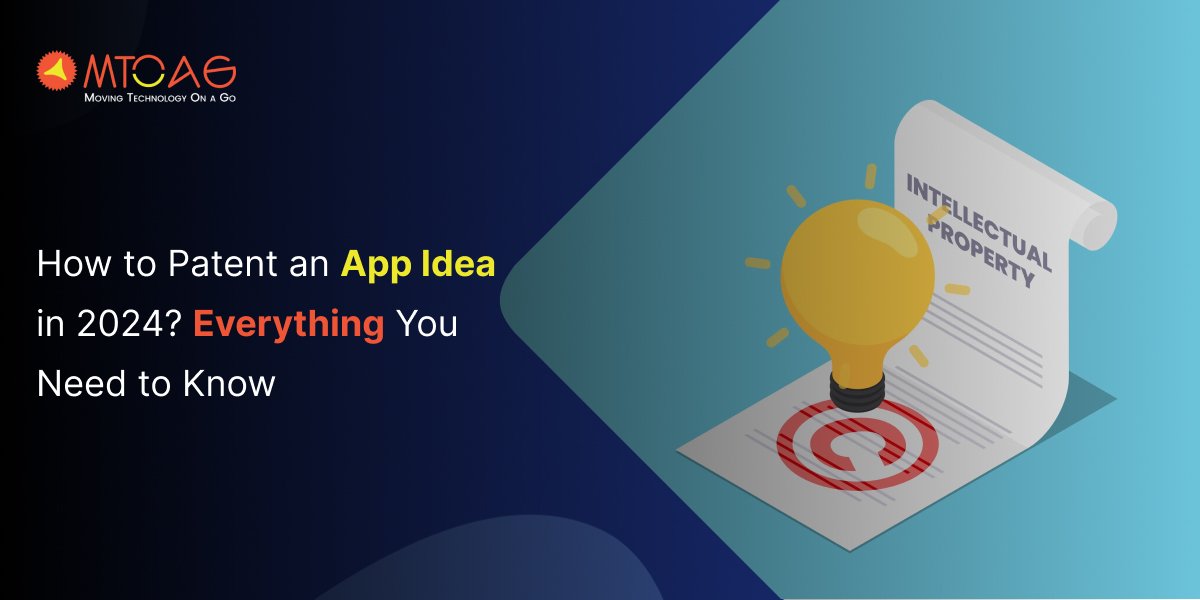
If your search for the best ways on “How to patent an app idea” lands you here, the chances are that you have probably got a ground-breaking idea. All you now need is guidance on how to do it quickly and easily. Worry not! This guide is going to be the one you have been searching for.
Every successful venture today was once an idea. The smartphones you use, the TV you watch, Facebook, Instagram—literally every modern invention—were just ideas at first. What transformed these ideas into successful ventures was the unique imagination and innovative concepts of their creators. But wait, what if these ideas had been leaked? Who would know Mark Zuckerberg today? Probably nobody! That's why patenting an app idea is not just an option but a mandatory step to be followed in the mobile app development process.
Put yourself in the same scenario - imagine your unique app idea gets leaked, and someone else builds the app first and takes all the credit and profits you deserve. To avoid such a situation, all you need to do is read this comprehensive guide on ‘How to patent an app idea?’ By patenting your app idea, you can ensure no one claims credit falsely for your invention. So, let’s start this guide and understand every nitty-gritty of the app patent process.
Table of Contents
If you are still wondering why patenting an app idea is important, here are some important statistics you should know before making any decision.
Here’s a data visualization of countries with the highest patent applications: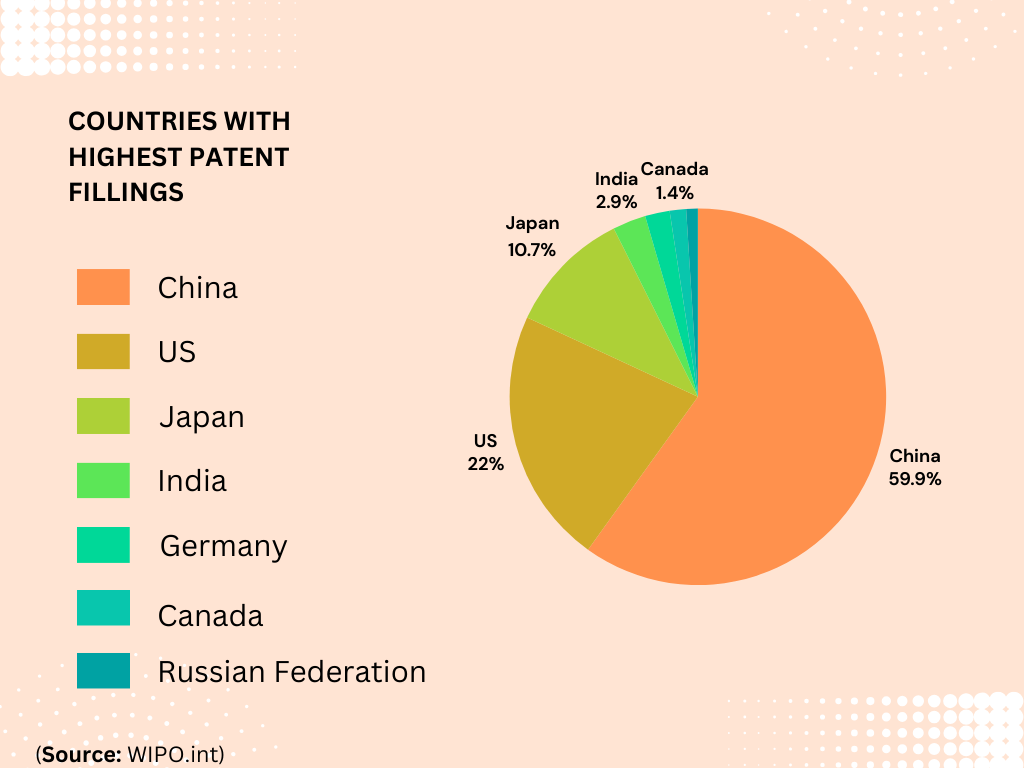
A patent can be understood as an exclusive intellectual property right for an invention. This right is solely possessed by the individual or organization that has created a unique product. In the same sense, patenting an app idea involves securing a unique, market-first app concept. A mobile app patent is a form of intellectual property right that safeguards your app against unauthorized replication, non-consensual usage, and illicit activities.
Moreover, a patented mobile app prevents other individuals or companies from creating duplicates or making unfounded claims. Once the relevant authority successfully patents a mobile app, it is assigned a unique patent code. This code serves as a verification tool for the patented mobile app concept, confirming its originality.
There are two types of patenting applications you can consider for your unique app idea. Both types have their advantages and disadvantages; choosing between them solely depends on your requirements.
The provisional patent application is a simple and popular method for securing your mobile app concept or the app itself. This type of application is recognized and utilized globally to protect originality and innovation. It's a more casual approach that doesn't require legal compliance to protect your mobile app or app concept. 
This method is a time-saver as the applicant doesn't need to deal with any legal procedures or implications. With the provisional patent application, you can file without any formal patent declaration claim or distributor statement. It provides a 12-month period to fully develop and refine the prototype. Plus, it allows you to use the term "patent pending" on the product. In terms of cost, the provisional patent application is less expensive compared to other applications.
This is another type of application that guarantees the protection of mobile app concepts or mobile apps. However, this process is more intricate. Suppose an individual intends to file a non-provisional patent application for their mobile app or concept. In that case, they should be aware that this method involves many legal procedures and complexities that must be addressed before obtaining the patent.
Even a single mistake can cause significant stress and disrupt the patent acquisition process. It is more time-consuming and costlier compared to the provisional patent application. This type of application must include claims and specifications. Furthermore, it should contain detailed information about the invention or app concept and at least one claim that legally outlines the app concept or application usage boundaries.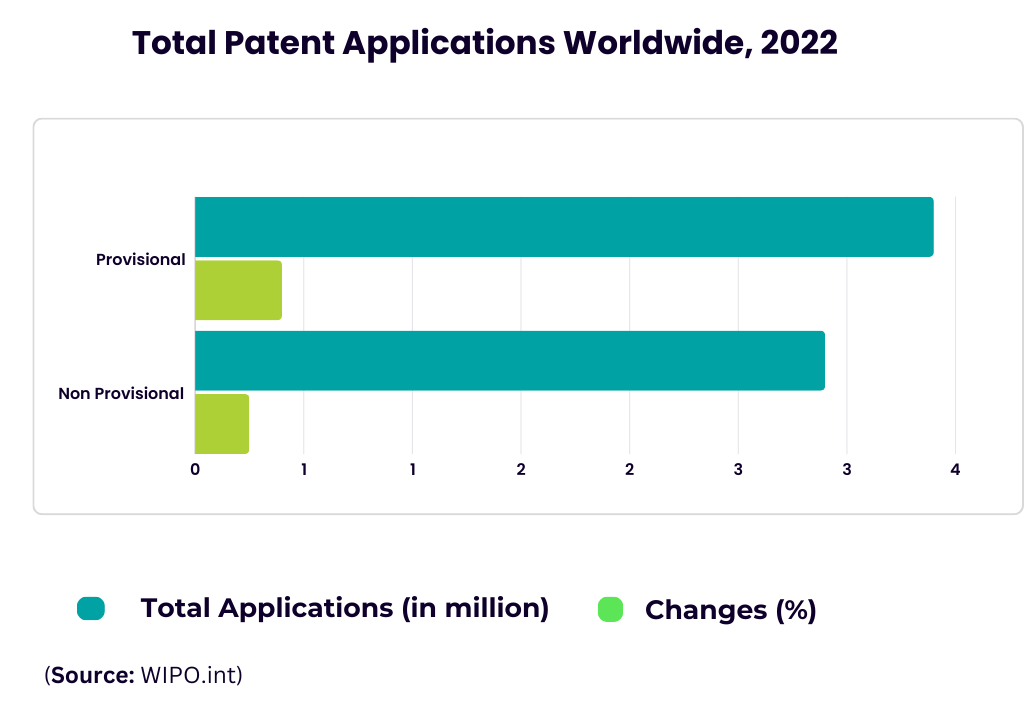
Having a unique mobile app idea can be thrilling and exciting. However, it's crucial to remember that the mobile app landscape is already crowded, with approximately 8.9 million apps worldwide. The Google Play Store has over 3.55 million, while the Apple App Store is home to 1.64 million apps.
Crafting a truly unique and original app idea in this mobile-centric world is challenging. It's not always clear-cut whether your app concept is entirely original and innovative. There's a significant possibility that your app idea has already been developed or registered.
So, before you proceed to apply for a patent, it's essential to ascertain if your app idea is eligible for one. Here are some factors to consider:
A great mobile application in itself doesn't guarantee uniqueness. You might improve upon an existing or already popular application, but that doesn't make your app unique. Therefore, conducting a discovery phase for your mobile application is crucial to ensure it's truly unique and offers features or solutions not found in other apps.
Adding features to an existing app concept won't work. For your app to be patent-eligible, its architecture, design, or problem-solving approach must be entirely unique.
Mobile app development can also be an invention if you create something distinct. If your mobile application provides one-of-a-kind solutions, it could be considered an invention and qualify for a patent. It's advisable to review the portfolios of leading mobile app development companies to gauge where your app stands in terms of innovation.
Given the vast number of apps available, many apps share similarities in certain aspects. Therefore, if your app idea is a clone or a modified version of other apps, it won't be eligible for a patent. For example, developing an e-commerce app like Etsy & Amazon with some unique features won't qualify you to patent your app idea.
Just having an innovative mobile app idea doesn't guarantee a patent. The patent for an app idea is awarded not to the first person who came up with the idea but to the first one who officially applied for it.
Your unique mobile app idea can only be protected by intellectual property rights when you have formally submitted an application to the relevant authority. Before you move to learn how to patent an app idea, here are certain prerequisites that you need to meet before applying for a patent.
Patents are granted to protect inventions only. They don't prevent anyone from working on a concept that's already in the market as long as there's no existing patent claim for the same product. Therefore, you should conduct thorough market research and undergo a comprehensive product design and discovery phase. This will help you confirm that your app is truly unique. If your app is found to be similar to another mobile application, your patent application may be rejected by the patent office.
Applying for a patent requires a lot of paperwork and documentation. The rules for mobile app patents vary across different countries. Therefore, you should conduct proper research to identify the documents required for patenting a mobile app idea. Typically, you will need the following documents:
A mobile app includes several technical and non-technical components to make it fully functional. Therefore, when applying for a patent, you must clearly define what you want to patent in your mobile application. Here are some common aspects or features that you can patent. You can also seek assistance from a mobile app development company to analyze this aspect:
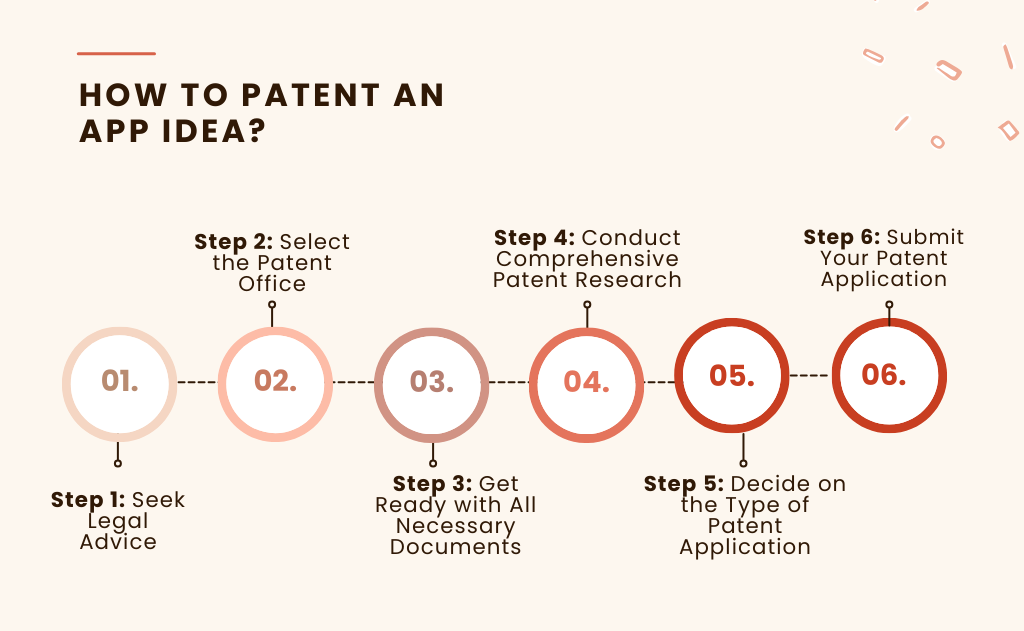
Securing a patent for your mobile app idea requires you to go through a lengthy legal procedure. Here are the steps you need to take to obtain intellectual property rights for your mobile app successfully:
The patent application process is complex and requires a well-structured and properly written application for smooth approval. It's advisable to seek the help of a patent attorney or a legal expert with extensive experience in patent procedures. This professional will guide you through the process until you successfully secure a patent for your app.
Each country has a specific government agency or legal authority responsible for granting patents for intellectual property. Their application procedures and policies may vary. Therefore, based on your location or preference, select the patent office where you will apply for your mobile app patent. Here are some well-known patent offices that grant patents for mobile apps and other technical intellectual properties:
Patenting an app idea involves several crucial steps and a lot of paperwork. You need to prepare various documents and legal forms. So, before you officially apply, ensure you have all the required items as per the most recent patent application policy. To do this, you should verify with the relevant patent office.
Conduct thorough research to determine if your app idea already exists in the market and has been patented. This will confirm that your app idea or the element you wish to patent is entirely unique and not already patented by someone else. For this, you should securely share the details of your app with your development team and patent attorney.
They will help you ensure that no similar ideas have already been patented in the market. At this stage, many app owners make mistakes by not providing accurate app details, leading to incorrect decisions. Therefore, app owners should employ effective methods to convey their app ideas to the development team.
As mentioned earlier, there are two types of patent applications: provisional and non-provisional. Depending on your objectives and the scope of your project, decide which type of patent application is suitable. Remember, each type of patent application has different provisions and rules, so choose wisely before proceeding with the official process.
Finally, when you are fully prepared, you should submit your patent application to the USPTO, WIPO, or any other patent office recommended by your patent attorney. The patent filing process can be exhausting and complicated, so assistance from your patent attorney can simplify this process. After submitting your patent application, you will need to wait for the patent approval.
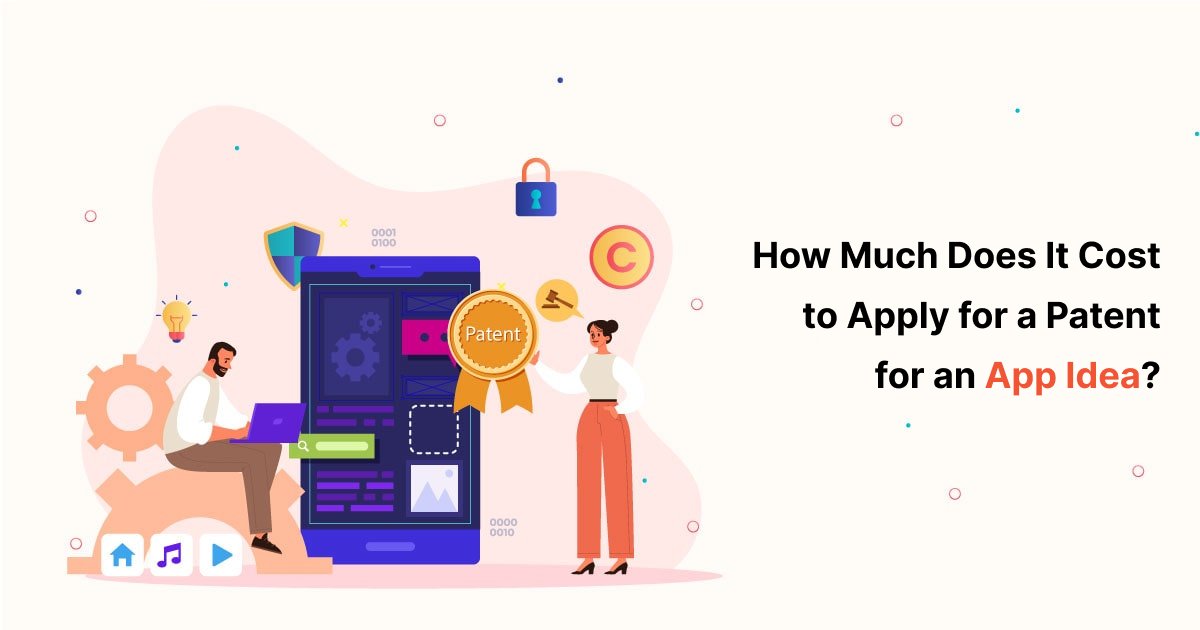
The cost associated with patenting a mobile application is influenced by numerous factors, including the type of patent, the intricacy of the invention, the geographical extent of protection, legal costs, fees charged by the patent office, the cost of conducting a patent search and analyzing prior art, maintenance costs, and more.
Your patent expenses are divided into several categories, such as:
Taking all these points into account, you can expect that a provisional patent application could cost you between $2000 and $5000. Conversely, the cost for a non-provisional patent can be anywhere from $10,000 to $15,000.
Securing a patent might not always be the best course of action for every app developer, and here's why:
The entire patenting process, from conducting research, preparing paperwork, and filing to examination, can be a long and tedious journey. This often results in significant time and financial investment, making it unaffordable for many.
Despite investing heavily in hiring a patent attorney, preparing patent documents, filing, and other associated costs, there's no assurance that your patent application will be accepted.
Filing a patent application means your mobile app concept becomes part of the public domain. This allows your competitors to access your idea and potentially implement it, even if the patent hasn't been granted.
Even after securing a patent, enforcing it can be challenging and costly. The complexity and duration of patent infringement lawsuits can make it difficult for app developers to protect their patent rights against third parties.
While patents for apps provide significant advantages to you as the app owner, there are also other patent alternatives that offer similar protections, including

This is a form of Intellectual Property Rights (IPR) that safeguards original works of authorship, such as art, literature, music, computer programs, and other creative content. By copyrighting your app's idea, code, and graphic elements, you can prevent others from copying, distributing, or reproducing your app without your consent.
However, it's important to note that copyright only protects the process behind the idea. In the context of a mobile app, you can copyright the app's idea and logo but not the entire app. Your app does not encompass ideas, facts, operational methods, or systems.

While patents prevent others from selling or reproducing your invention, a trademark safeguards your app's content, logos, icons, and other identifiers from being used by others, which could confuse consumers.
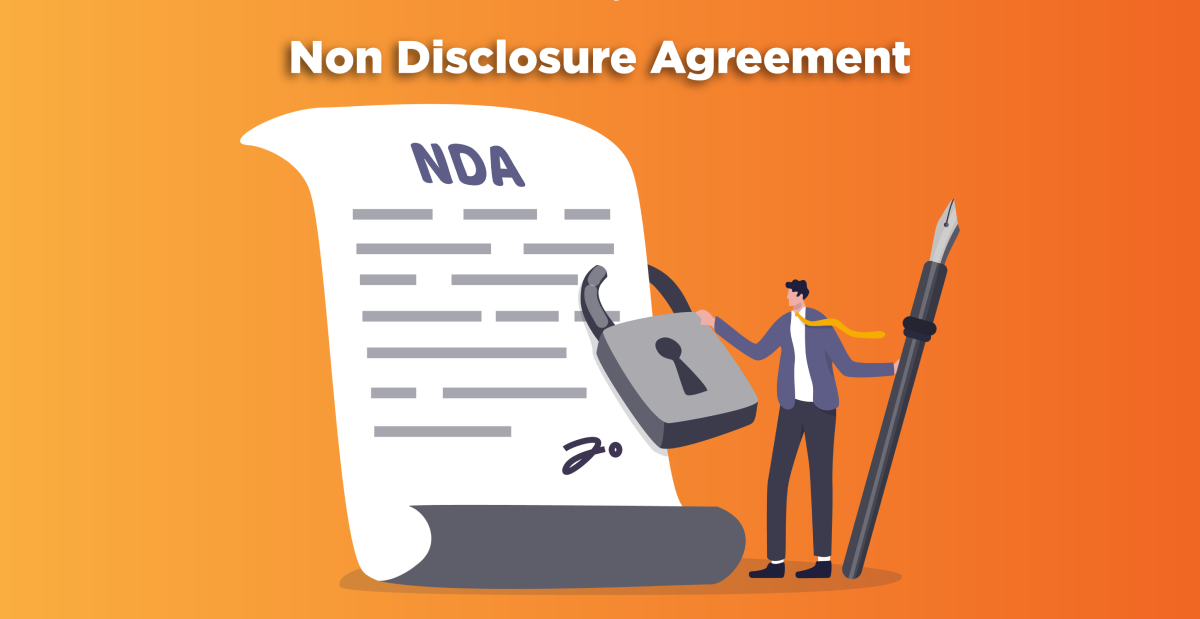
An NDA is an IPR agreement that you can establish and have your mobile app development partner sign. It prevents them from disclosing your identity and any information about your project. In essence, an NDA legally obligates your partners to keep the details of your project confidential and protect them from imitators.
Now that you have understood everything about app idea patenting, it's time to implement your knowledge. The most effective way to ensure your idea achieves its potential is by creating a Minimum Viable Product (MVP). This serves as a solid base for showcasing your concepts and gathering insights from consumers.
But there's more to consider. Believe us, this is something you don't want to miss. Research indicates that a third of all startups were initiated with less than $5,000, with no certainty of success. However, with an MVP, early adopters like you can truly benefit from understanding the needs of your target market.
At Mtoag Technologies, our seasoned developers can help you efficiently and economically build an MVP app that meets your expectations.
We're committed to turning our client's ideas into reality through our expertise - from wireframing, coding, and testing to deployment on any app platform you require.
So, that’s it in this comprehensive guide on how to patent an app idea, which involves a series of steps and procedures. If you have any questions about mobile app development, transforming an app idea into reality, obtaining a patent for your app idea, or the cost of hiring mobile app developers to create an app, feel free to reach out to us.
As a top-tier mobile app development company, we've successfully developed more than 2500 apps across various categories. To connect with us, simply complete our contact form, and a sales team member will respond to you promptly.
Rest assured, this consultation is completely free of charge. We're here to help you navigate the exciting world of app development.
The cost of patenting an app varies, but it typically ranges from $2,000 to $15,000, including attorney fees and filing costs.
Selling an app idea involves refining the idea, researching the market, protecting intellectual property, creating a business plan, and finding the right buyer.
To patent your own idea, you need to ensure it qualifies for a patent, then prepare and file a patent application with the help of a patent attorney.
Patenting an app can protect its unique functionalities from being copied. However, not every aspect of an app is patentable, and the process can be costly and time-consuming.
Patents protect inventions, while copyrights protect original works of authorship. The choice between patent and copyright depends on what you're trying to protect.
Patents are expensive due to the complexity of the application process, the expertise required, and various fees such as filing and maintenance fees.
Yes, Patents do expire. Utility and plant patents last 20 years, and design patents last 15 years. After expiration, the invention becomes part of the public domain.